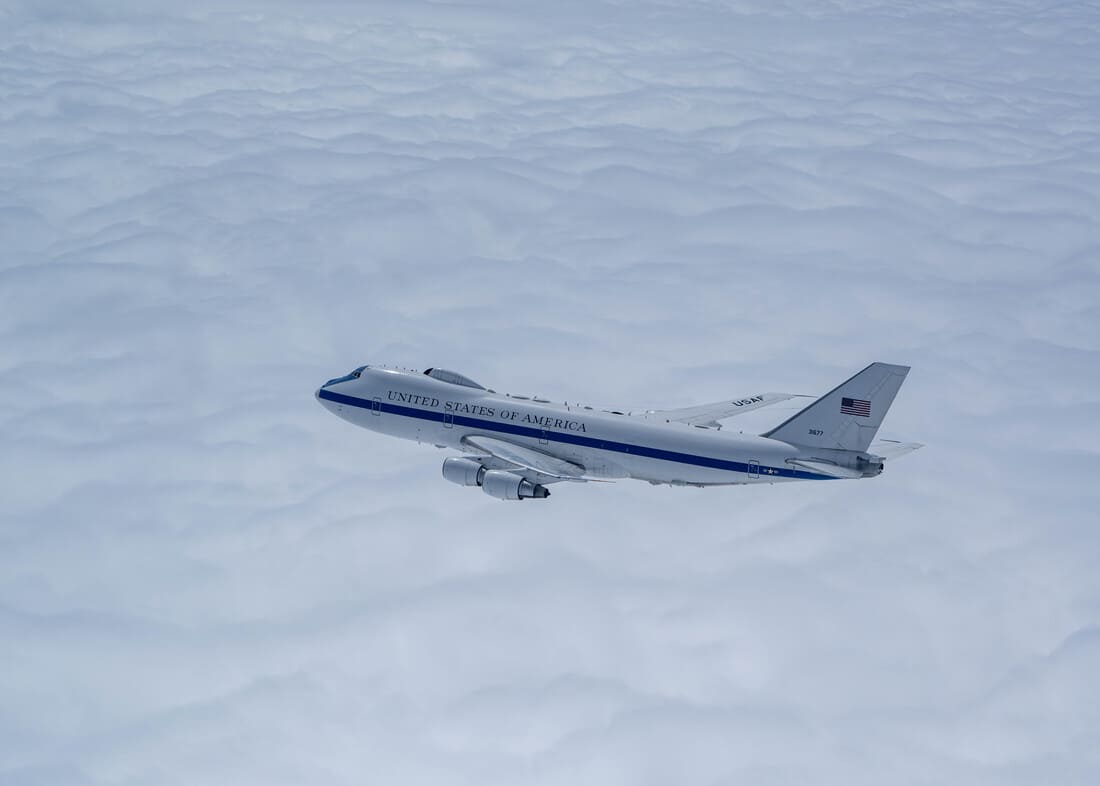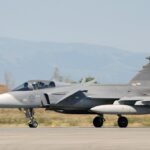The first company-led flight of the Survivable Airborne Operations Center took place on Aug 7, 2025, out of the Aviation Innovation and Technology Center at Dayton International Airport. The prime contractor reported the sortie as the opening step in a structured test series. Early work stays focused on flying qualities, instrumentation, and safety gates rather than mission equipment. The aim is to lock down the aircraft’s technical baseline before heavy modifications begin.
The Air Force and Sierra Nevada confirmed the campaign schedule runs into 2026 with activity at two hubs, Dayton, Ohio and Wichita, Kansas. The company’s notice lists ground trials and additional flights on the same timeline. The target is to complete baseline verification ahead of major interior and exterior conversions. Defense officials say Wichita will handle instrumentation and pre-mod readiness in parallel with the Dayton flying schedule.
Program materials refer to the platform as the Survivable Airborne Operations Center, the successor to the E-4B National Airborne Operations Center. Several trade outlets use the “E-4C” label for the new aircraft. The contractor describes the mission set without publishing detailed subsystem layouts. The core purpose remains the same: an airborne command, control, and communications node for senior leadership in a national emergency, with hardening and redundant power to keep the aircraft operational when ground nodes suffer disruption.
Initial sorties emphasize airworthiness and data collection, not operational scenarios. According to industry sources, the team is running a conservative envelope expansion with incremental increases in duration and altitude, with rapid instrumentation reviews between flights. The pacing item right now is test-planning throughput rather than airframe availability. That matches the contractor’s early flight approach disclosed over the past month.
Contract scope, five 747-8I conversions, and the delivery window to July 2036
The Department of the Air Force awarded a contract in April 2024 covering five aircraft to replace the four E-4B Nightwatch jets. The total contract value sits at $13 billion, with completion scheduled by July 2036. The award documents place development, integration, aircraft purchase, modification, and initial support under a single program structure.
The contractor describes a phased path. Acquire airframes, establish a consistent green-jet configuration, build and integrate the mission system, then proceed to acceptance. Defense officials confirm the conversion sequence uses a rolling pattern rather than a batch approach. Each tail moves forward as its instrumentation and structural checks clear. The contract language holds detailed performance baselines in government systems, while the company communicates schedule anchors in broad terms.
Early flight testing forms part of the engineering and manufacturing development phase. Press statements from late summer explain why the team is flying before full internal conversion. The flights collect data to validate assumptions in digital models and to uncover integration risks while the aircraft remain close to transport configuration. That data then feeds design reviews and supports certification planning for structural and electromagnetic protection work.
Delivery timing remains tied to the availability of the selected 747-8I airframes and to the throughput of new facilities the contractor is bringing online in Dayton. The company and the Air Force have not released an aircraft-by-aircraft calendar. The public end date and the rolling conversion plan imply overlapping modification lines once heavy mission install kits reach maturity. According to industry sources, the intent is to avoid long queue times between green-jet arrival and the start of structural work.
747-8I sourcing and the industrial footprint in Dayton and Wichita
Sierra Nevada obtained five passenger-configured 747-8Is that Korean Air retired, with delivery of those aircraft to the contractor scheduled by September 2025 under the seller’s filing. The transaction provided the large-cabin, long-range, four-engine baseline the Air Force insisted on when it began planning the follow-on to the E-4B.
Four of those airframes arrived at the contractor’s Dayton campus across 2024 and early 2025, according to program updates and local reporting. The site houses flight-test support, a large MRO hangar, staging areas for interior removal, and cranes sized for wide-body work. The company signaled additional hangars at the airport will expand usable floor space to more than 650,000 square feet by early 2026, adding capacity for simultaneous induction of multiple jets.
The Wichita line supports instrumentation, teardown planning, and pre-mod documentation. University and regional facilities there received one of the early 747-8Is from Dayton in late 2024. The hand-off created a second node for structural inspections and material characterization. That shortens lead times for engineering changes once full conversion starts.
Design aims, survivability measures, engines and power systems partnerships
The selection of the 747-8I keeps the General Electric GEnx-2B engines, a point the company highlighted when it outlined supplier roles last year. Rolls-Royce joined the team to provide auxiliary power systems to support high electrical loads and ground-independent operations. The team tapped Collins Aerospace for elements tied to nuclear command, control, and communications. Those choices align with the aircraft’s job as an airborne command post with long on-station endurance and extensive communications gear.
EMP hardening, radiation shielding, and specialized antennas appear across every official description of the program’s end state. The contractor has not published antenna counts, structural reinforcement details, or exact cable routing, which is expected for a platform with this mission. Public statements instead stress resilience and secure communications while withholding fine-grained diagrams.
Rolls-Royce described its role in May 2024 and framed the aircraft as a survivable command center for senior leadership during a national emergency. The description tracks with long-standing Air Force statements about the mission of the E-4B fleet the SAOC will replace. The survivability package typically includes shielding, line-replaceable units designed for shock and thermal tolerance, and redundant power buses so the aircraft can keep operating if one path fails.
The contractor has emphasized a modular open-systems approach for mission hardware. The structure allows incremental refresh of processors, radios, and displays without deep rewrites of the entire software stack. It also simplifies vendor changes over a program life measured in decades. The plan described in spring 2024 placed the digital model of the aircraft at the center of integration, with flight data now feeding updates to that model after the August sortie.
Outward changes visible early are limited. Window and door layouts match the donor jets, with most work in planning spaces, instrumentation racks, and data systems. Heavy exterior work such as antenna farms, added apertures, and structural reinforcements comes later, after baseline flight-test data closes remaining validation items. The sequence mirrors standard practice on large conversions and fits the schedule the contractor laid out for 2025-2026.
The current E-4Bs date to 1970s-built 747-200 airframes and carry different engines and systems. Those jets have logged decades of service as the National Airborne Operations Center and remain available until SAOC tails enter service. Their age and parts situation drove the Air Force to start recapitalization and to seek a platform with newer engines and a longer support horizon.
Sierra Nevada’s Dayton campus continues to grow to meet those demands. The firm cut ribbons on a second 100,000-square-foot building in late 2024 and reported two more hangars on the way, one slated for opening this October and another in early 2026. Company figures point to more than 650,000 square feet available by then, enough to support multiple wide-body lines and the staging areas needed for large mission kits.
Program facts and current status
The Air Force communicates three fixed points for the next 18 months.
- The first flight on Aug 7, 2025, completed at Dayton.
- Second, flight and ground testing continue into 2026 at Dayton and Wichita to establish the technical baseline.
- Third, the prime is holding to a conversion plan that sequences aircraft as they clear instrumentation and structural checks.
Defense officials confirm these points line up with the government’s internal schedule.
The donor airframes arrived through a commercial transaction rather than a direct government buy of new-build jets, which closed off years ago when the 747 line ended. The Korean Air sale addressed a key constraint, finding multiple 747-8Is with compatible records and maintenance histories. The airline’s filing placed deliveries to the contractor by September 2025 and listed a total value of roughly $674 million at the time of the notice.
Facility growth at Dayton supports those inductions. Public construction updates describe high-bay hangars with cranes and firefighting systems sized for wide-body work, plus adjacent office space for engineering teams. The layout shortens the distance between flight-test parking, instrumentation bays, and modification cells. That cuts towing time and reduces coordination overhead across the campus.
Stakeholders in Wichita, including university-linked aerospace labs, documented the arrival of an early aircraft in December 2024 and described their role in structural analysis and pre-mod preparation. The choice of Wichita adds capacity from a region steeped in wide-body modification work and keeps the program close to existing tooling and experience. The Air Force has used those assets on previous special-mission conversions and sustainment efforts.
Industry teams usually face long-lead challenges on power distribution and environmental control systems when converting wide-body transports into command posts. Supplier notes from last year make clear that auxiliary power, high-capacity generators, and electrical architecture are early design drivers on SAOC. Rolls-Royce’s role on the power side and retention of GEnx-2B engines fix some variables. That helps limit the range of integration outcomes engineers must cover in testing.
Our analysis shows the pace and sequencing in 2025-2026 aim to reduce uncertainty before structural cuts escalate. Early flights feed the digital model and shorten rework loops once the modification line starts full-rate tasks. The approach lines up with the contractor’s public description of its digital-first workflow and the Air Force’s stated need for predictable induction timing across all five tails.
People, places, and timelines
Dayton anchors the near-term schedule. The airport’s long runway and available ramp space allow multiple wide-bodies to cycle through test and maintenance without crowding. The contractor’s growth plan brings total floor space past 650,000 square feet by early 2026, sufficient for concurrent induction, interior strip, structural reinforcement, and mission install teams. Local reporting in September underscored the October 2025 opening of the next hangar, keeping that expansion on a visible clock.
Wichita handles a different slice of the work. Instrumentation, materials testing, and engineering support there tie into decades of regional experience with Boeing wide-body modification. The Air Force gains from that split, test aircraft can shuttle between sites as milestones complete, while documentation and analysis progress off the flight line. The hand-off documented in late 2024 set the pattern for that partnership.
Inside the Air Force, program managers keep the messaging narrow and factual. They point to the five-aircraft quantity, the long-range four-engine requirement, the $13 billion ceiling, and the July 2036 completion date. They avoid public discussion of specific antenna counts, interior layouts, or communications waveforms. The posture matches the mission and the classification of many subsystems on the current E-4B fleet.
The legacy jets remain in service. Those airframes entered the fleet decades ago and continue to carry the National Airborne Operations Center mission while SAOC proceeds through design, test, and conversion. Sustainment and parts obsolescence issues raised the urgency for recapitalization, and the service now has a schedule and industrial base layout built around the 747-8I.
Supplier roles and technical boundaries
Engine retention reduces risk in nacelle integration, engine control software, and certification. The GEnx-2B has a documented record on the 747-8I and a robust support ecosystem. Auxiliary power and electrical distribution still require heavy customization for SAOC, given the load from communications racks and thermal management demands. Supplier notes put Rolls-Royce on that part of the job, a role that includes power availability on the ground without external carts.
Communications architecture will define much of the interior. The government and contractor avoid disclosing exact equipment lists, but open-systems language signals the ability to rotate in new radios, cryptographic devices, and processors across the program life. The approach also supports software refresh without disrupting every cabinet and cable run. The contractor has used similar methods on other special-mission aircraft, which helps with workforce training and configuration control.
Electromagnetic pulse hardening and radiation protection remain central. Public descriptions speak to shielding and redundancy instead of part numbers, a practice consistent with the current E-4B. Expect structural reinforcements around critical bays, zoned power, and cable separation strategies to prevent single-point failures.
What changes next
Near-term milestones fall into three buckets. Additional flight sorties at Dayton. Continued instrumentation and planning work at Wichita. Opening of the next Dayton hangar in October 2025. The contractor’s late-summer update also mentioned three additional 747-8Is delivered to the enterprise, building the queue for conversion. As those facilities come online, the program can stagger induction dates to keep each tail moving through teardown, structure, and mission install without idle time on the ramp.
Defense officials confirm the government is not publishing an operational test start date, and the contractor has not issued a public in-service date for the first tail. The published July 2036 completion line remains the only calendar point beyond the 2026 baseline-establishment year. The service’s messaging stays cautious, with few claims about performance and a focus on schedule facts and facility progress.
The current reporting window shows a program pacing itself on measured steps. Flight test on a largely stock airframe may look modest, yet it gives engineers what they need before cutting into structure. Instrumentation work in Kansas tackles the other half, gathering loads, vibration, and environmental data that feed detailed design. The two sites, plus donor jets arriving from commercial service, set up the conversion effort for the next phase through 2026.
REFERENCE SOURCES
- https://www.shookconstruction.com/sierra-nevada-corporation-aviation-innovation-and-technology-center
- https://www.sncorp.com/news-archive/snc-and-us-air-force-begin-flight-test-activities-at-dayton-s-aviation-innovation-technology-center/
- https://www.defensenews.com/air/2025/09/04/flight-tests-begin-on-us-air-forces-new-doomsday-plane/
- https://theaviationist.com/2025/09/04/usaf-e-4c-saoc-begins-flight-testing/
- https://www.daytondailynews.com/local/snc-begins-doomsday-plane-flight-testing-in-dayton/BXGZD3INXJCM7KP24D46VIDACM/
- https://www.reuters.com/business/aerospace-defense/korean-air-sells-five-jets-us-aerospace-firm-sierra-nevada-2024-05-08/
- https://www.sncorp.com/news-archive/snc-wins-us-air-force-contract-to-develop-next-gen-survivable-airborne-operations-center-saoc-aircraft/
- https://www.defensenews.com/air/2024/05/31/sierra-nevada-gears-up-to-build-us-air-force-doomsday-planes/
- https://www.rolls-royce.com/media/press-releases/2024/22-05-2024-rr-partners-with-snc-on-us-air-force-survivable-airborne-operations-center.aspx
- https://www.wichita.edu/about/wsunews-releases/2024/11-nov/saoc_release_3.php
- https://insidedefense.com/insider/saoc-begins-flight-testing
- https://www.sncorp.com/news-archive/snc-continues-significant-growth-at-aviation-innovation-and-technology-center-in-dayton/



